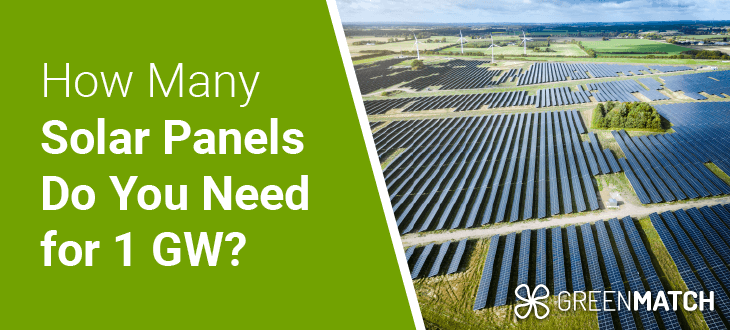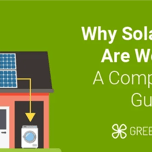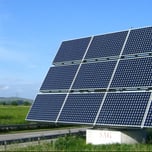Answer these simple questions and we will find you the BEST prices
Which type of solar quotes do you need?
It only takes 30 seconds
100% free with no obligation

Get up to 4 quotes by filling in only 1 quick form

Slash your energy bills by installing solar panels

For the average 2-3 bedroom house
- GreenMatch
- Solar Energy
- Solar Panels
- How Many Solar Panels To Produce A Gigawatt?
How Many Solar Panels To Produce A Gigawatt? (October 2025)

Solar power is a renewable energy source that is becoming increasingly popular due to its environmental and financial benefits. Currently, there are over 228 GW of solar photovoltaic (PV) and wind power combined in the world. With this in mind, we’re here to answer how many solar panels are needed to generate 1 GW of power.
This article will explore the size of a 1-gigawatt solar farm and its components, as well as the various other considerations that come into play when attempting to produce this much power. It will also consider the advantages and disadvantages of solar power in comparison to other forms of energy production.
Finally, it will discuss how the size of a 1-gigawatt solar farm relates to other forms of energy production.
While you may not have the ability to produce 1 gigawatt, you might still be looking for solar power solutions for your home or office. If so, Greenmatch can help you find the best solar company in your area. Simply fill out our 30-second form and we’ll provide you with up to 4 free quotes from certified solar installers. Feel free to compare them with no obligation to place any orders.
- Quotes from local engineers
- Payment by finance available
- Save up to £1,567 per year
It only takes 30 seconds



✔ 1 gigawatt (GW) of power is equivalent to 1 billion watts.
✔ To produce 1 gigawatt of power, it would require approximately 3.125 million photovoltaic (PV) panels.
✔ The representative silicon model panel size for photovoltaic panels is typically around 320 watts.
How much power is 1 GW?
A gigawatt is a unit of power equal to one billion watts and is generally used to measure large-scale energy production such as the output of a photovoltaic or wind energy system.
To put this into perspective, to generate a gigawatt of energy, 3.125 million solar panels would be required.
Solar panel efficiency is also important, as this determines how much energy the panel can convert from sunlight into electricity. Ergo, by opting for highly efficient solar panels, a solar farm can maximize energy production and minimize the number of solar panels required.
Solar panel efficiency
Modern solar panels are incredibly efficient, converting sunlight into electricity with an efficiency rate of up to 20%. The most efficient solar panels per square foot are hybrid solar panels, so they would be the best for optimising space.
They are also incredibly durable, with most having a lifespan of 25-30 years. Installing 3.125 million panels would be a major endeavour, but it is feasible given the energy output and efficiency rate.
Solar panels also require plenty of sunlight in order to produce energy, and this is an important factor to consider when installing a solar farm. The amount of sunlight available varies from region to region and how well they work can vary in winter, so the environment must be taken into account when determining the size of the solar farm.
Sunlight availability
Accounting for the regional environment is key when planning the size of a Gigawatt power farm, as the amount of sunlight available can vary significantly.
Solar panel orientation plays an important role in maximizing the amount of sunlight harvested, as the angle of the panel is a critical factor in determining its efficiency.
A solar panel should be oriented in the direction that receives the most direct sunlight, which can be affected by the seasonal and daily tilt of the sun. Factors such as weather, clouds, dust, and air pollution can also reduce the amount of sunlight reaching the solar panel.
To illustrate this, the following table compares the daily amount of sunlight available in the UK:
| Country | Average sunlight hours/day |
|---|---|
| England | 4.1–4.6 |
| Scotland | 3.9–4.4 |
| Wales | ~3.7 (depends on the season) |
| Northern Ireland | 3.5–3.7 |
The amount of sunlight available for a 1-gigawatt solar farm will depend on the region where the farm is located. This is different for solar panels in England, solar panels in Scotland and solar panels in Wales.
By optimizing the orientation of the solar panels, farmers can maximize the amount of solar energy harvested and reduce the size of the solar farm. With careful planning, solar farms can be designed to meet their power generation goals while taking into account available space.
Available space
The amount of space needed for a 1-gigawatt solar farm will vary depending on the region and the orientation of the solar array. Depending on the geographic location, the amount of available space, and the solar panel density, the size of the solar farm could range from approximately 3.125 million photovoltaic (PV) panels to 333 utility-scale wind turbines.
Some of the factors to consider when determining how much space is needed for a 1gW solar farm include
- Solar panel density. The number of solar panels that can be installed in a given area is determined by the size of the solar panels, the available space, and the amount of sunlight available.
- Orientation of the solar array. The optimal orientation of the solar array can maximize the amount of energy produced by the solar panels.
- Amount of available space. If the available space is limited, the number of solar panels that can be installed will be limited as well.
The next step is to determine the size of the solar panels that will be used in the solar farm.
Solar panel size
Determining the size of the solar panels used in a 1-gigawatt power farm is essential in order to maximize energy production. Solar panel technology has advanced to the point where a 1 GW solar farm can be made up of different types of photovoltaic panels with varying levels of wattage.
The table below provides a comparison of the various power sources, from photovoltaic panels to wind turbines, that can be used to generate a gigawatt of energy.
| Power source | Number needed |
|---|---|
| Photovoltaic (PV) Panels | 3.125 million |
| Utility-scale Wind Turbines | 333 |
| Light-emitting Diodes (LED) | 100 million |
| Horses | 1 million |
| Chevy Corvette Z06 Engines | 2,000 |
| Nissan Leaf Motors | 9,090 |
The size of the panels used in a 1 GW solar farm can range significantly depending on the type of panel chosen. For instance, a representative silicon model panel size for photovoltaic panels is 320 watts, while the average size of a utility-scale wind turbine installed in 2021 is 3 MW. As the wattage of the panel increases, the number of panels needed decreases significantly.
By utilizing the right solar panel technology, a 1 GW solar farm can be constructed in a much smaller area than previously thought. As the understanding of solar panel technology continues to develop, the size of solar farms will continue to decrease.
Solar panel wattage
The wattage of the solar panels used in a 1gW solar farm has a significant impact on how efficiently energy is produced. As the wattage of the panel increases, the amount of energy produced by the panel increases, thus resulting in higher power output and lower costs in the long run.
The lifespan of the solar panel is also important when considering its wattage. Higher wattage panels tend to have a longer lifespan, as they are better able to handle the wear and tear associated with exposure to the sun.
Additionally, higher-wattage panels tend to be more efficient in converting sunlight into electricity. This makes them a more cost-effective choice, as they can produce more energy at a lower cost.
With these considerations in mind, it is essential to choose solar panels with the appropriate wattage for a 1 GW solar farm. These considerations will ultimately play a role in the overall cost of the solar farm.
Cost considerations
Installation methods have a significant impact on cost. The most cost-effective ways will require the least number of panels, as well as the lowest labour costs for setup.
Battery storage is another important element in the cost considerations for a 1gW solar farm. It requires the installation of additional equipment and the expenditure of additional resources.
While searching for the best price, you can sacrifice your valuable time off with your family in favour of googling and reaching out to installers. However, you might still end up disappointed with zero reliable contacts at your fingertips.
Fortunately, GreenMatch can help you skip frustrating searches. By filling out a 3-second form, you can receive up to 4 free quotes from local solar panel installers. Just compare the prices and rest assured – you have no hidden fees to pay and no obligation to place any orders. Click below to begin!
- Quotes from local engineers
- Payment by finance available
- Save up to £1,567 per year
It only takes 30 seconds



Grid integration
Grid integration is the key to unlocking the potential of solar power, and with the right storage system, a solar farm can remain productive even when the sun isn't shining. Battery storage systems can provide a reliable source of energy, allowing the solar farm to respond to the demand of the grid while providing the necessary safety and efficiency standards.
With the proper integration, a solar farm can remain connected to the grid and remain profitable, even during times of low demand. By carefully considering the battery storage options available, a 1 GW solar farm can be equipped with a system that is both cost- and energy-efficient. This can ensure that the solar farm remains profitable and productive for years to come.
The next step in optimizing the solar farm is to ensure that the energy produced is converted from direct current (DC) to alternating current (AC) in the most efficient manner.
Conversion of DC to AC
Converting the direct current (DC) generated by a 1gW solar farm into alternating current (AC) requires careful consideration of the most efficient methods available. To maximize the lifespan of solar panels, it is important to consider the conversion system's cooling capabilities, power conversion efficiency, and maximum input voltage.
The cooling capabilities of the converter system must be designed to handle the amount of heat generated by the solar panels, while the power conversion efficiency must be high enough to ensure that the power produced by the solar panels is accurately transferred into AC power.
The maximum input voltage of the converter system must be equal to or greater than the output voltage of the solar panels in order to prevent damage to the solar panels.
The table below summarizes the factors that affect the conversion of DC from a 1gW solar farm to AC. Each factor is crucial in ensuring the optimal lifespan and performance of the solar farm.
| Factor | Description |
|---|---|
| Cooling capabilities | The converter system must be able to handle the amount of heat generated by the solar panels. |
| Power conversion efficiency | The converter system must have a high enough power conversion efficiency to accurately transfer the power from the solar panels to AC. |
| Max input voltage | The converter system must have a maximum input voltage that is equal to or greater than the output voltage of the solar panels. |
By taking these factors into account, it is possible to ensure the optimal lifespan and performance of the solar panels when converting DC to AC. With the right converter system, a 1 GW solar farm can have the power it needs to serve its purpose for many years to come.
Installation considerations
When installing a 1 GW solar farm, careful consideration must be given to maximize the lifespan and performance of the system. Key factors to consider include the number and placement of solar panels, the availability of land space, and the climate of the area.
Solar panel placement is an important factor to consider when installing a Gigawatt power farm. Solar panels should be placed in an area that receives the most sunlight throughout the day, and the angle and orientation of the panels should be adjusted accordingly.
Furthermore, solar panels should be placed at a distance that maximises the system's efficiency, while also avoiding overcrowding and shading. Additionally, consideration should be given to the land space available for the solar farm, as well as the climate of the area.
For example, high wind speeds may require additional measures to ensure the stability and safety of the solar panels.
Conclusion
The size of a 1-gigawatt solar farm depends on a variety of considerations, including solar panel efficiency, sunlight availability, available space, and cost.
Once all of these factors are taken into account, the number of solar panels necessary to generate 1 GW of power can be determined.
With the right combination of solar panels, batteries, and conversion systems, a 1 GW solar farm can provide clean, renewable energy for many years to come.
Save time by obtaining up to 4 quotes from our extensive network of certified and screened solar panel installers, rather than contacting installers individually. Simply fill out our 30-second form to receive up to 4 free, non-binding quotes. Click the button below to get started.
- Quotes from local engineers
- Payment by finance available
- Save up to £1,567 per year
It only takes 30 seconds



FAQ
Solar panels have a long life span, typically lasting 25-30 years. With proper maintenance, solar energy systems can produce clean, renewable energy for decades.
Urban zoning is an important factor to consider when installing solar panels. Local governments have varying restrictions on where they can be installed, ranging from residential areas to commercial buildings. Understanding the regulations of each jurisdiction can help ensure a successful solar panel installation and inspire efficient and innovative energy sources.
A 1-gigawatt solar farm produces an average of 1 billion watts of renewable energy, enough to power millions of homes. Its innovative use of photovoltaic panels, wind turbines, and LEDs creates a visionary source of clean and sustainable energy, inspiring us to take control of our future.
The construction and operation of a 1 GW solar farm could have a significant impact on the climate, potentially helping to reduce greenhouse gas emissions and mitigate the effects of climate change. By taking advantage of renewable energy sources, the long-term environmental benefits can be profound.
We strive to connect our customers with the right product and supplier. Would you like to be part of GreenMatch?

Stay up to date with energy saving tips and grant alerts
Receive offers, marketing and promotions via email from Leads.io about GreenMatch and our brands/partners to help you save.
Thank you for subscribing to our newsletter!
Your email has been successfully added to our list. We look forward to sharing our latest updates with you soon!




